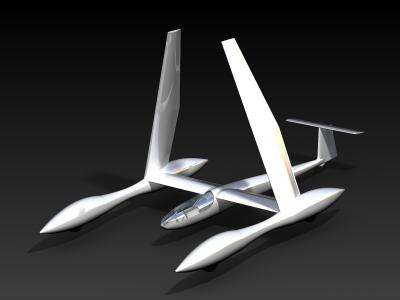A yacht designed to magnify the wind

(PhysOrg.com) -- A team of mechanical engineering students is aiming to set a world land speed record in the Mojave Desert.
Luke Yoder was 16 years old when he hitched his sail plane to a friend’s power plane and got a lift 3,000 feet up into the Kansas sky. There, he unhooked the connecting cable and rode the thermals, turning and soaring from one column of rising air to the next, climbing 3,000 feet higher, waving to other pilots and watching the birds float past.
Today, Yoder is a mechanical engineering junior at Lehigh University and he is trying once again to harness the wind. He and several other engineering students have spent two years designing and building a land yacht with which they hope to set a world speed record. The project is supervised by Joachim Grenestedt, professor of mechanical engineering and mechanics and holder himself of a speed record or two.
A land yacht has a wing-like sail, tires and a fuselage. The pilot, or driver, seeks to maximize the lift supplied by the wind and minimize the drag imposed by air and tires, while keeping the tires on the ground. Racers compete on a flat, natural surface and hope for a day with strong winds and no rain.
Those conditions prevailed in March 2009 on Lake Ivanpah along the California-Nevada border in the Mojave desert, when Richard Jenkins, a British engineer, set the current land speed record of 126.1 mph for a wind-powered vehicle.
Yoder witnessed Jenkins’ historic feat, which got a boost from a 40-mph wind.
“Jenkins raced on the dry lake bed alongside Interstate 15,” Yoder recalled. “At first all the cars were passing him. Then he caught up, then he shot past. You need perfect wind conditions to do this.”

Ivanpah, 2011: A radical design, and an emphasis on tires
One year later, the goal of Yoder and his teammates is simple—to return to Ivanpah next March and break a record that took Jenkins 10 years to set.
Yoder, Edward Stilson ’11, Evan Mucasey ’11 and several other students call themselves the Lehigh University Land Yacht Speed Record Project, or LYSRP. They are pinning their hopes on a radical yacht design and superior tire performance.
A land yacht pilot magnifies the speed of the wind by maintaining a narrow angle between the yacht’s sail and the direction of the wind. The smaller this angle is, the more speed a yacht draws from the wind’s force.
As the yacht moves, however, its wing generates a force that is perpendicular to the wind’s direction. This force contains a large sideways component, apart from the forward component that propels the craft. To maintain a straight course, a yacht must counter the side force with an equal and opposite force provided by its tires. Yacht designers seek a tire configuration that maximizes the quotient between tire side force and tire drag. This in turn maximizes the speed of the yacht.
Instead of the sails of conventional land yachts, the Lehigh craft will draw lift from vertical wings that are mounted 5 meters out from each side of the fuselage. Yoder says the setup, which Grenestedt designed, will give the pilot unprecedented aerodynamic control over yaw, pitch and roll.
To determine the optimal configuration of the yacht’s four tires, Yoder’s team has developed a tire-testing rig with wheels that can be adjusted to simulate the side forces the tires must counter and with sensors that measure side force and drag. Test data is stored on a computer, where it can be viewed in real time. LYSRP members are varying dozens of factors in trial runs.
Taking aim at the jet stream in the stratosphere
Yoder is working on a second project involving flight through Lehigh’s IPD (Integrated Product Development) program, in which students in engineering, business and the arts collaborate one year to make and market products. Yoder’s team is testing part of a balloon launch system designed to release an unmanned glider into the jet stream 60,000 feet above the earth’s surface. The project is supervised by Grenestedt and John Spletzer, associate professor of computer science and engineering. The glider would remain aloft for months performing surveillance or communications tasks.
In a container of dry ice that simulates the -80-degree chill of the stratosphere, Yoder’s IPD group is testing a heating element that would be directed by a flight computer to cut a cord to release the glider at the desired elevation.
Yoder is president of Lehigh’s rugby club and also an Eckardt Scholar. The honors program allows students with unusual promise or creativity to do advanced scholarly work.
Yoder grew up in Japan and California and spent summers in Kansas. His parents did not keep a TV in the house, so he and his two younger brothers learned to entertain themselves. Besides sailing, Luke took part in robot competitions, and he spent many hours with his father in the family garage.
The land yacht project is a natural fit.
“I like working with designs no one has tried before. We hope to break the speed record, but if we don’t, we’ll have fun trying.”
Provided by Lehigh University

















